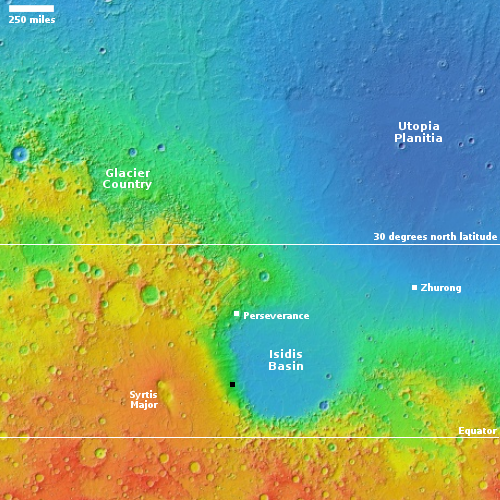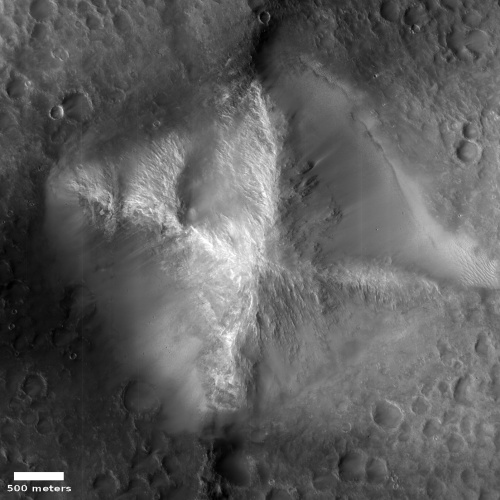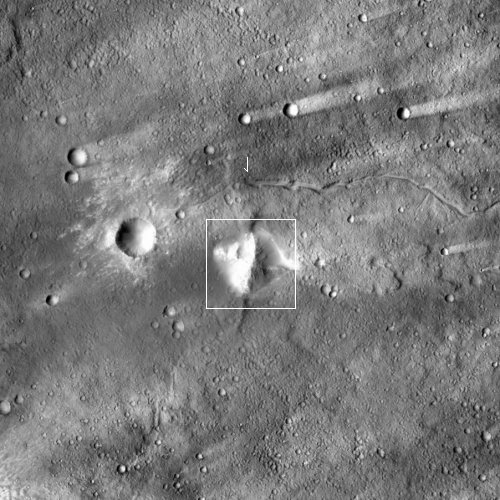A pyramid on Mars
Cool image time! The picture to the right, rotated, cropped, and reduced to post here, was taken on January 21, 2023 by the high resolution camera of Mars Reconnaissance Orbiter (MRO). It shows what the scientists label a “pyramidal mound”, which is I think understating the point somewhat.
This pyramid is almost perfectly square, with two perpendicular ridgelines rising from its corners to meet perfectly at the pyramid’s peak. A similar pyramid mound in the Cydonia region, where the so-called “Face on Mars” was found, caused endless absurd speculations in the 1990s of past Martian civilizations, all of which burst into nothingness when good high resolution images were finally obtained in the 2000s.
But what caused this very symmetrical natural feature?

The first picture to the right is an overview map, the black dot about 325 miles almost due south of Perseverance marking the location of this pyramid. This spot, on the fringe of Isidis Basin to the east and the shield volcano Syrtis Major to the west, tells us a lot. Isidis was formed by a large impact four billion years ago, and contains many volcanic features. Syrtis is one of Mars’ many gigantic volcanoes, and once spewed flood lava more than 200 miles in all directions about three billion years ago, covering the surface in a wide area so that few craters are seen around it.
The second picture was taken on January 2, 2022 by the context camera on MRO, showing a wider area for context. The white rectangle indicates the area covered by the high resolution photo. Note the fissure to the north of the pyramid, with its head marked by the arrow. The grade downhill is almost certainly to the east, and this fissure, following that grade, is almost certainly a lava flow feature with the arrow indicating the vent from which the lava discharged.
What all of this additional information suggests is that this pyramid is likely a volcanic lava feature of some kind. Possibly the upward push of lava at this point failed to break the surface for some reason — as happened at that vent to the north. The result was this mound instead.
None of this information however really explains why if is shaped as it is. If any scientists have come up with an explanation, however, it is difficult to find it because online searches are still overwhelmed by the silly theories from the 1990s about non-existent Martian civilizations building faces and pyramids on Mars. There might be a geological paper on this subject, but I could not find it.
On Christmas Eve 1968 three Americans became the first humans to visit another world. What they did to celebrate was unexpected and profound, and will be remembered throughout all human history. Genesis: the Story of Apollo 8, Robert Zimmerman's classic history of humanity's first journey to another world, tells that story, and it is now available as both an ebook and an audiobook, both with a foreword by Valerie Anders and a new introduction by Robert Zimmerman.
The print edition can be purchased at Amazon or from any other book seller. If you want an autographed copy the price is $60 for the hardback and $45 for the paperback, plus $8 shipping for each. Go here for purchasing details. The ebook is available everywhere for $5.99 (before discount) at amazon, or direct from my ebook publisher, ebookit. If you buy it from ebookit you don't support the big tech companies and the author gets a bigger cut much sooner.
The audiobook is also available at all these vendors, and is also free with a 30-day trial membership to Audible.
"Not simply about one mission, [Genesis] is also the history of America's quest for the moon... Zimmerman has done a masterful job of tying disparate events together into a solid account of one of America's greatest human triumphs."--San Antonio Express-News
Cool image time! The picture to the right, rotated, cropped, and reduced to post here, was taken on January 21, 2023 by the high resolution camera of Mars Reconnaissance Orbiter (MRO). It shows what the scientists label a “pyramidal mound”, which is I think understating the point somewhat.
This pyramid is almost perfectly square, with two perpendicular ridgelines rising from its corners to meet perfectly at the pyramid’s peak. A similar pyramid mound in the Cydonia region, where the so-called “Face on Mars” was found, caused endless absurd speculations in the 1990s of past Martian civilizations, all of which burst into nothingness when good high resolution images were finally obtained in the 2000s.
But what caused this very symmetrical natural feature?

The first picture to the right is an overview map, the black dot about 325 miles almost due south of Perseverance marking the location of this pyramid. This spot, on the fringe of Isidis Basin to the east and the shield volcano Syrtis Major to the west, tells us a lot. Isidis was formed by a large impact four billion years ago, and contains many volcanic features. Syrtis is one of Mars’ many gigantic volcanoes, and once spewed flood lava more than 200 miles in all directions about three billion years ago, covering the surface in a wide area so that few craters are seen around it.
The second picture was taken on January 2, 2022 by the context camera on MRO, showing a wider area for context. The white rectangle indicates the area covered by the high resolution photo. Note the fissure to the north of the pyramid, with its head marked by the arrow. The grade downhill is almost certainly to the east, and this fissure, following that grade, is almost certainly a lava flow feature with the arrow indicating the vent from which the lava discharged.
What all of this additional information suggests is that this pyramid is likely a volcanic lava feature of some kind. Possibly the upward push of lava at this point failed to break the surface for some reason — as happened at that vent to the north. The result was this mound instead.
None of this information however really explains why if is shaped as it is. If any scientists have come up with an explanation, however, it is difficult to find it because online searches are still overwhelmed by the silly theories from the 1990s about non-existent Martian civilizations building faces and pyramids on Mars. There might be a geological paper on this subject, but I could not find it.
On Christmas Eve 1968 three Americans became the first humans to visit another world. What they did to celebrate was unexpected and profound, and will be remembered throughout all human history. Genesis: the Story of Apollo 8, Robert Zimmerman's classic history of humanity's first journey to another world, tells that story, and it is now available as both an ebook and an audiobook, both with a foreword by Valerie Anders and a new introduction by Robert Zimmerman.
The print edition can be purchased at Amazon or from any other book seller. If you want an autographed copy the price is $60 for the hardback and $45 for the paperback, plus $8 shipping for each. Go here for purchasing details. The ebook is available everywhere for $5.99 (before discount) at amazon, or direct from my ebook publisher, ebookit. If you buy it from ebookit you don't support the big tech companies and the author gets a bigger cut much sooner.
The audiobook is also available at all these vendors, and is also free with a 30-day trial membership to Audible.
"Not simply about one mission, [Genesis] is also the history of America's quest for the moon... Zimmerman has done a masterful job of tying disparate events together into a solid account of one of America's greatest human triumphs."--San Antonio Express-News




This is nothing compared to the “Mr Peanut” crater(s) a few posts back. You can even see him monocle nearby…..
An oblique view of this feature would be interesting.
On the picture showing the “fissure to the north of the pyramid”, what is causing the shadowing or smearing moving left to right?
All I can think is “Richard Hoagland!” If only Art Bell was still with us, it would be a highly entertaining show.
Chris asked, “what is causing the shadowing or smearing moving left to right?”
My guess is prevailing winds, coming from the west, blowing dust out of the craters.
All hail Sutekh! Got to phone this in at the nearest Police Call Box.
Jeff-
excellent obscure cultural reference.
Interesting that there aren’t any wind smears evident from the ‘pyramid’ and the close-up seems to look smudged on the sides of it while the craters in the same picture are sharply defined.
Just saying.
Sven: I think the downhill grade to the east, matching the direction of the prevailing winds, helps explain this. The dust can get out of the smaller craters, but the pyramid act somewhat as a block.
Nonetheless, there is evidence of smearing to the east of the pyramid as well. Look at the context camera picture.
Bob so the prevailing winds remain constant in direction? I would expect a singular event.